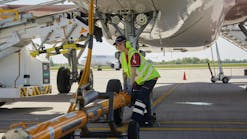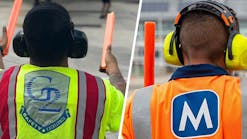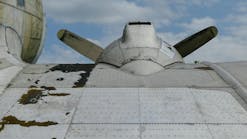Safety issues with advanced composite materials
By Greg Mellema
The last 25 years has seen a dramatic rise in the use of advanced composite materials on aircraft. Since these materials aren't as old and well-sorted-out as the metal technology traditionally used to build aircraft, companies often struggle with how to effectively manage composite materials, not only from a repair standpoint, but a safety standpoint as well.
Getting a firm grasp of the safety issues associated with composite materials is a difficult task at best. Accurate information concerning the real hazards posed by composite materials is difficult to come by and even more difficult to stay abreast of. The following is a discussion of the hazards generally associated with advanced composite materials. It is by no means all-inclusive, but it will give you a basic understanding of the kind of safety issues you need to be on the lookout for.
The hazards associated with the repair of advanced composite structures can be divided into three basic categories; matrix resins, reinforcement fibers, and a short list of miscellaneous issues peculiar to composite materials.
Matrix systems
There are literally hundreds of different resin matrix systems. Some of the
more common thermoset resins include bismaleimide (BMI), polyimide, and phenolic, but the single most common resin system used in aerospace today is epoxy. Epoxies are well suited for use as matrix materials; they have excellent adhesive properties and come in a wide range of strength, durability, and processing options.
Unmixed epoxy resins typically come in liquid form and in two parts, the base resin (component A) and the hardener (component B). When these are mixed together in the correct proportions they cross-link, or cure, to create a durable solid material. While there are certainly exceptions, component A is generally considered to have a relatively low order of toxicity. Component B, however usually contains aromatic and/or aliphatic amine compounds. These corrosive amines are skin, eye, and often, respiratory irritants. Many modern aircraft call for the use of prepreg materials to affect structural repairs. Prepreg is fabric that has previously been impregnated with a mixed resin. The resin is then "B-staged," or partially cross-linked until it no longer flows at room temperature. While these materials are less messy and more convenient to use, the resins still contain amines and other compounds, so contact with the skin or eyes must be avoided.
Reinforcement fibers
The most common reinforcement fibers found in the aerospace industry are carbon and graphite fiber, Aramid fiber (Kevlar®), and fiberglass. These materials are chemically inert and pose no health risk while in their dry fabric form or when cured in a resin matrix. However, machining a cured laminate liberates short fibers and allows them to become airborne. It is these airborne fibers that are a potential concern. The long, thin shape of such a fiber may cause it to become trapped deep in the lung and damage lung tissue.
At the end of the bronchial passages in the lung are tiny sacks called alveoli. Through the walls of the alveoli gas exchange takes place. Your blood gives up carbon dioxide and takes on oxygen to be distributed throughout the body. If a fiber is inhaled and manages to penetrate the alveoli, it typically becomes lodged inside. Ultimately this fiber scars the tissue and renders the alveoli incapable of gas exchange.
OSHA uses the term "respirable" to describe fibers of this type and respiratory protection must be used to limit their inhalation. In order to qualify as respirable a particle must have an aerodynamic diameter of less than 3 microns. Aerodynamic diameter is the most important determinant of the respirability of a fiber; it is different from its actual geometric diameter. The aerodynamic diameter of a fiber takes into account the fiber's density and aspect ratio as well as its geometric diameter. Fibers larger than this are deposited in the nose, or on the tracheal or bronchial walls where they are disposed of by normal lung clearance mechanisms.
What is important to understand is that when advanced composite materials are machined or abraded, the resin matrix shatters liberating tiny filaments (fibers) of random length. Fiberglass and carbon/graphite filaments essentially maintain their original diameter during the machining process. Only aramid fibers show a mild tendency to shear down their length and generate sub-fibers, or "fibrils." Therefore, one can form some opinions as to what hazards are posed from the dust generated during composite machining operations based on the filament diameters. Carbon and graphite fibers tend to be about 7 microns in diameter, aramid fibers about 8 microns, and glass fibers range from 3 to 25 microns with the vast majority being 6 microns or larger. If the cut-off for fibers in the respirable category is 3 microns then, in theory, none of these materials poses a respiratory hazard. On the other hand we used to think asbestos was perfectly safe too.
The fact is that a small amount of the fibers and more of the pulverized resin dust can fall into the respirable category. The first question then becomes what is the permissible exposure limit (PEL). At the moment, it is generally recommended that dust from machining carbon, aramid, and glass fiber composites be controlled to standards for particulates not otherwise classified (NOC). The PEL for particulates NOC is 15 milligrams per cubic meter, 5 milligrams of which is allowed to be respirable. OSHA, the American Conference of Governmental Industrial Hygienists (ACGIH), and the U.S. military have recommended a somewhat lower PEL for carbon fiber of 10 milligrams per cubic meter (5 milligrams respirable).
Once we know what the exposure limit is, the second question becomes how much am I being exposed to? This is a question for your industrial hygienist and your safety officer to wrestle with. What is supposed to happen is this: An industrial hygienist conducts sampling of the air an employee is breathing during the machining and grinding operations that are typically conducted in your facility. The samples are analyzed to establish how much, and what kind of dust personnel are being exposed to. This information along with some recommendations is turned over to your safety officer in the form of a written report. It is the safety officer's job to compare the actual exposure to the regulated exposure limits (PEL and TLV) and decide what sort of engineering controls need to be in place and what personal protective equipment will be required for certain tasks.
Composite particulars
Every industry
has its own set of unique safety issues to deal with and composites are no exception. Two common safety concerns that arise are uncontrolled exotherm and sensitization.
Uncontrolled exotherm
When we mix epoxies, molecules of the base resin cross-link to those of the hardener as it cures. A by-product of this reaction is heat. If the resin is spread out over a large surface area the heat dissipates naturally and the resin cures at a predictable rate. However, if a sufficient quantity of mixed resin is left in a container, the heat cannot escape and builds up in the resin. This by itself might not be a problem except that for every 18-degree (F) rise in temperature, the rate of cross-linking doubles. So as the heat builds within the resin mass it accelerates the cross-linking, which creates more heat, and so on. The resultant bubbling, smoking, fiery mess is called an uncontrolled exotherm. It is often called a runaway, or hot batch by shop personnel. The smoke from such an occurrence is toxic and inhalation should be avoided at all costs.
The best solution for the problem of uncontrolled exotherms is prevention. Never mix more resin than you really need for the job and never allow mixed resin to remain in a container longer than absolutely necessary. Get it out of the container and into the work as quickly as possible.
Sensitization
The phenomenon
of sensitization has plagued the aviation industry for many years. Although it is more commonly associated with paints and coatings, it can also be caused by contact with matrix resin systems. Sensitization can best be likened to an allergic reaction that develops upon repeated exposure to a chemical. It can generally be classified in one of two ways. Dermal sensitization, which manifests itself as a skin rash, or respiratory sensitization, which elicits an asthmatic reaction and can be quite severe.
It is important to understand that with sensitization reactions, the severity or extent of the reaction does not necessarily relate to the degree of exposure. A person who is sensitized to a certain substance can react strongly when exposed to trace amounts of it. Some medical details about sensitization are still not fully understood, but this much we know for sure, your chances of becoming sensitized to a substance go up with every exposure. Once sensitized there is no "cure," and you'll be forced to find another line of work. Again, the simple solution is prevention. Always wear appropriate personal protective equipment (PPE) when working with resins. Minimum PPE would be the proper gloves, apron, and safety glasses or goggles when working with wet resins. Gloves alone will normally suffice when working with prepreg materials.
Conclusion
Remember, these are generalities. There are so many different fiber and resin types out there that we can't possibly discuss them all here. When it comes to the issue of safety and composite materials, rumors abound. The only way to be sure you're adequately protected is to educate yourself. Understand how a substance can affect your body, read MSDS, make sure your organization has current exposure reports from an industrial hygienist, and communicate with your safety personnel to maintain a safe working environment.
Greg Mellema is an instructor with Abaris Training in Reno, Nevada. Abaris conducts training in repair, fabrication, and design of advanced composite aircraft structures. Mellema holds both an Airframe & Powerplant certificate as well as an Inspection Authorization (I.A.). He earned his B.S. degree in Professional Aeronautics from Embry-Riddle Aeronautical University and is currently working on a double Master's degree in Aviation Safety and Aviation Management.




